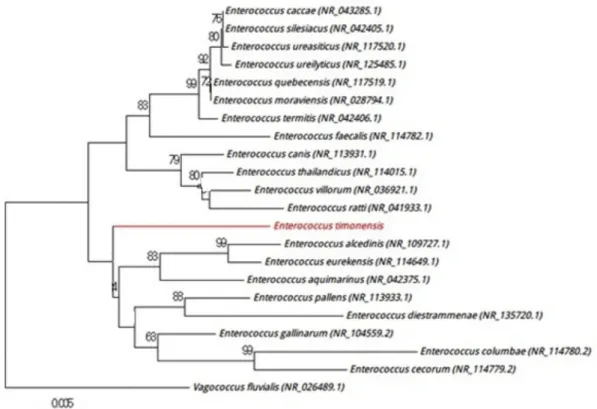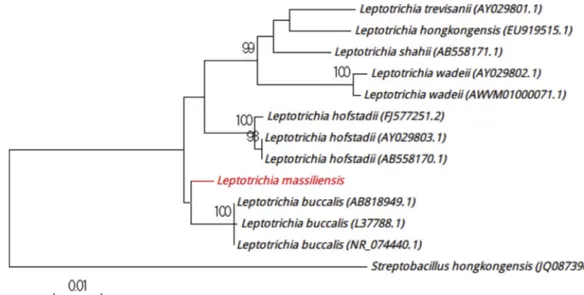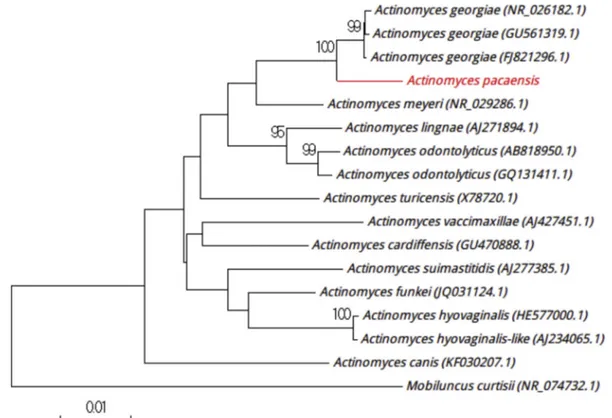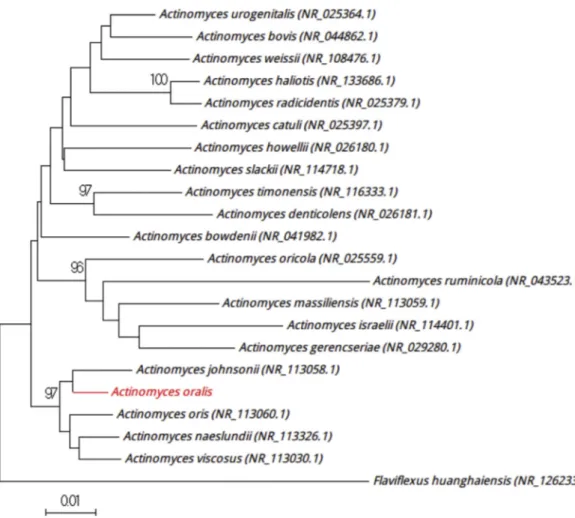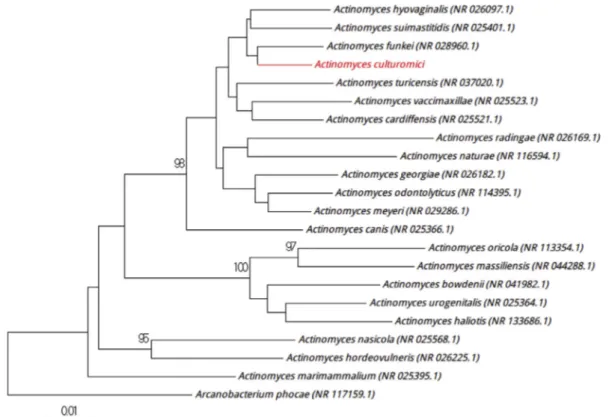HAL Id: hal-01794771
https://hal-amu.archives-ouvertes.fr/hal-01794771
Submitted on 17 May 2018
HAL is a multi-disciplinary open access
archive for the deposit and dissemination of
sci-entific research documents, whether they are
pub-lished or not. The documents may come from
teaching and research institutions in France or
abroad, or from public or private research centers.
L’archive ouverte pluridisciplinaire HAL, est
destinée au dépôt et à la diffusion de documents
scientifiques de niveau recherche, publiés ou non,
émanant des établissements d’enseignement et de
recherche français ou étrangers, des laboratoires
publics ou privés.
Distributed under a Creative Commons Attribution - NonCommercial - NoDerivatives| 4.0
International License
‘Enterococcus timonensis’ sp. nov., ‘Actinomyces
marseillensis’ sp. nov., ‘Leptotrichia massiliensis’ sp.
nov., ‘Actinomyces pacaensis’ sp. nov., ‘Actinomyces
oralis’ sp. nov., ‘Actinomyces culturomici’ sp. nov. and
‘Gemella massiliensis’ sp. nov., new bacterial species
isolated from the human respiratory microbiome
D. Fonkou, M. Bilen, F. Cadoret, Pierre-Edouard Fournier, G. Dubourg,
Didier Raoult
To cite this version:
D. Fonkou, M. Bilen, F. Cadoret, Pierre-Edouard Fournier, G. Dubourg, et al.. ‘Enterococcus
timonen-sis’ sp. nov., ‘Actinomyces marseillentimonen-sis’ sp. nov., ‘Leptotrichia massilientimonen-sis’ sp. nov., ‘Actinomyces
pacaensis’ sp. nov., ‘Actinomyces oralis’ sp. nov., ‘Actinomyces culturomici’ sp. nov. and ‘Gemella
massiliensis’ sp. nov., new bacterial species isolated from the human respiratory microbiome. New
Mi-crobes and New Infections, Wiley Online Library 2018, 22, pp.37 - 43. �10.1016/j.nmni.2017.12.005�.
�hal-01794771�
‘Enterococcus timonensis’ sp. nov., ‘Actinomyces marseillensis’ sp. nov.,
‘Leptotrichia massiliensis’ sp. nov., ‘Actinomyces pacaensis’ sp. nov.,
‘Actinomyces oralis’ sp. nov., ‘Actinomyces culturomici’ sp. nov. and ‘Gemella
massiliensis’ sp. nov., new bacterial species isolated from the human
respiratory microbiome
M. D. Mbogning Fonkou1, M. Bilen1, F. Cadoret1, P.-E. Fournier1, G. Dubourg1and D. Raoult1,2
1) Aix-Marseille Université, URMITE, UM 63, CNRS 7278, IRD 198, INSERM U1095, Faculté de Médecine, Marseille, France and 2) Special Infectious Agents Unit, King Fahd Medical Research Center, King Abdulaziz University, Jeddah, Saudi Arabia
Abstract
We report the main characteristics of‘Enterococcus timonensis’ strain Marseille-P2817T(CSUR P2817),‘Leptotrichia massiliensis’ sp. nov., strain Marseille-P3007T(CSUR P3007),‘Actinomyces marseillensis’ sp. nov., strain Marseille-P2818T(CSUR P2818),‘Actinomyces pacaensis’ sp. nov., strain Marseille-P2985T(CSUR P2985), ‘Actinomyces oralis’ sp. nov., strain Marseille-P3109T(CSUR P3109), ‘Actinomyces culturomici’ sp. nov., strain Marseille-P3561T(CSUR P3561) and‘Gemella massiliensis’ sp. nov., strain Marseille-P3249T(CSUR P3249) which were isolated from human sputum samples.
© 2017 Published by Elsevier Ltd.
Keywords: Actinomyces sp. nov., Enterococcus timonensis, Gemella massiliensis, Leptotrichia massiliensis
Original Submission: 15 September 2017; Revised Submission: 1 December 2017; Accepted: 7 December 2017 Article published online: 14 December 2017
Corresponding author: D. Raoult, Aix-Marseille Université, Unité de Recherche sur les Maladies Infectieuses et Tropicales Emergentes (URMITE), CNRS 7278, IRD 198, INSERM 1095, UM63, Institut Hospitalo-Universitaire Méditerranée-Infection, Faculté de médecine, 27 Boulevard Jean Moulin, 13385, Marseille cedex 5, France E-mail:didier.raoult@gmail.com
Culturomics has proven its efficiency in the description of the human microbiome at different levels and has enlarged the known human prokaryotic repertoire[1,2]. Nevertheless, our laboratory succeeded in identifying a significant number of bacterial species that could not be identified by our systematic matrix-assisted desorption ionization–time of flight mass spectrometry (MALDI-TOF MS) screening on a Microflex spectrometer (Bruker Daltonics, Bremen, Germany)[3,4]. The corresponding reference spectrum is available online (http:// mediterraner-infection.com/article.php?laref=256&titre=urms-database). As part of the project aiming to describe the human
respiratory microbiome by culturomics, we were able to isolate several new species not previously reported.
Before we began our study, it was validated by the ethics committee of the Institut Fédératif de Recherche IFR48 under number 09-022. Sputum samples were collected from different participants and incubated in a modified blood culture bottle (Becton Dickinson, Le Pont de Claix, France). A follow-up of 30 days was performed, and colony identification was done by MALDI-TOF MS and 16S rRNA gene sequencing in case of failure as previously described. All strains that we report here failed to be identified by MALDI-TOF MS.
Strain Marseille-P2817 was isolated on 5% sheep’s blood–enriched Columbia agar (bioMérieux, Marcy l’Etoile, France) at 37°C from a sputum sample of a healthy Frenchman after incubation of 10 days in an aerobic blood culture bottle (Becton Dickinson) supplemented withfiltered rumen. The colonies were smooth with a 1 mm diameter. Moreover, bacterial cells were Gram-positive cocci, motile and non–spore forming, with a mean diameter of 0.65 μm and a mean length of 1.1μm. Strain Marseille-P2817 did not
New Microbe and New Infect 2018; 22: 37–43 © 2017 Published by Elsevier Ltd This is an open access article under the CC BY-NC-ND license (http://creativecommons.org/licenses/by-nc-nd/4.0/)
exhibit either catalase or oxidase activities and showed a 96.00% sequence identity with Enterococcus casseliflavus strain Kd7 TUC-EEAOC (GenBank accession no. KM096606), which is phylogenetically the closest species with standing in nomenclature (Fig. 1). Because strain Marseille-P2817 has a 16S rRNA gene sequence divergence of >1.3% with its phylogenetically closest species with standing in nomencla-ture [5], we suggest the creation of a new species called ‘Enterococcus timonensis’ (ti.mo.nen’sis, N.L. masc. adj., tim-onensis from the Latin name of Hôpital de la Timone, where strain Marseille-P2817 was isolated). Strain Marseille-P2817T is the type strain of the new species‘Enterococcus timonensis.’ Likewise, strain Marseille-P3007 was cultured directly on 5% sheep’s blood–enriched Columbia agar (bioMérieux) at 30°C under anaerobic atmosphere. Although growth was observed at 37°C, it was optimal at 30°C. Colonies had a diameter ranging from 0.5 to 3 mm with a rough-edged appearance. Bacterial cells were nonmotile, spore-forming, Gram-positive rods and were catalase positive and oxidase negative with a diameter ranging from 0.67 to 0.8μm and a length ranging from 3.5 to 11.5 μm. Strain Marseille-P3007 showed a 98.3% sequence identity with Leptotrichia buccalis strain C-1013-b
(GenBank accession no. NR_114394), which is the phyloge-netically closest species with standing in nomenclature (Fig. 2). Because it had a sequence similarity of <98.65%[6], we pro-pose ‘Leptotrichia massiliensis’ (mas.il.i.en’sis, L. gen. neutr. n., massiliensis,‘of Massilia,’ the Latin name of Marseille, the place where the strain was isolated) strain Marseille-P3007 as new species. Strain Marseille-P3007T is the type strain of the new species‘Leptotrichia massiliensis.’
Strain Marseille-P2818 was isolated on 5% sheep’s blood– enriched Columbia agar (bioMérieux) from a sputum sample of a healthy Frenchwoman after 30 days of incubation at 30°C in a blood culture bottle (Becton Dickinson) supplemented with filtered rumen. The strain was able to grow at 28 to 37°C but optimally at 30°C. Colonies had a diameter ranging from 0.5 to 1.5 mm, with a smooth appearance. Bacterial cells were Gram-positive rods, nonmotile, non–spore forming, and catalase and oxidase negative. Strain Marseille-P2818 showed 98.14% sequence identity with‘Actinomyces odontolyticus’ strain F0309 (GenBank accession no. GQ131411), which is the phyloge-netically closest species with standing in nomenclature (Fig. 3). Because it had a sequence similarity of <98.65%[6], we pro-pose strain Marseille-P2818 as a new species named
FIG. 1.Positioning of‘Enterococcus timonensis’ strain Marseille-P2817 relative to other phylogenetically close neighbours in phylogenetic tree. Se-quences of strains involved were aligned by CLUSTALW, and phylogenetic inferences were obtained by MEGA 7.0 software using maximum-likelihood method. Numbers shown at nodes represent percentages of bootstrap values obtained after 500 repeats to generate majority consensus tree. Only bootstrap scores with minimum 90% score were retained. Scale bar indicates 0.5% nucleotide sequence divergence.
38 New Microbes and New Infections, Volume 22 Number C, March 2018
NMNI
© 2017 Published by Elsevier Ltd, NMNI, 22, 37–43
FIG. 2.Positioning of‘Leptotrichia massiliensis’ strain Marseille-P3007 relative to other phylogenetically close strains in phylogenetic tree. CLUSTALW was used to align sequences, and phylogenetic inferences were generated by MEGA 7.0 software with maximum-likelihood method. Scale bar indicates 1% nucleotide sequence divergence, and numbers at nodes are percentages of 500 bootstrap values obtained in order to generate consensus tree. Only bootstrap scores with minimum 90% score were retained.
FIG. 3.Positioning of‘Actinomyces marseillensis’ strain Marseille-P2818 relative to other phylogenetically close strains in phylogenetic tree. CLUSTALW was used to align sequences, and phylogenetic inferences were generated by MEGA 7.0 software with maximum-likelihood method. Scale bar indicates 1% nucleotide sequence divergence, and numbers at nodes are percentages of 500 bootstrap values obtained in order to generate consensus tree. Only bootstrap scores with minimum 90% score were retained.
‘Actinomyces marseillensis’ (mar.sei.ll.en’sis, L. gen. neut. adj., from marseillensis, the Latin name for Marseille, where the strain was isolated). Strain Marseille-P2818Tis the type strain of the new species‘Actinomyces marseillensis.’
Strain Marseille-P2985 was isolated from the sputum of a healthy Frenchman on 5% sheep’s blood–enriched Columbia agar (bioMérieux) at 37°C after incubation in a blood culture bottle (Becton Dickinson) supplemented with 4 mL filtered rumen at 37°C under anaerobic conditions. Colonies had a diameter ranging from 1 to 5 mm, and were smooth and white. Bacterial cells were spore-forming Gram-positive rods, nonmotile, and catalase positive and oxidase negative. 16S rRNA gene sequence–based identification of strain Marseille-P2985 showed 97.91% sequence identity with Actinomyces georgiae strain AGU5 (GenBank accession no. GU561319), which is the phylogenetically closest species with standing in nomenclature (Fig. 4). Because it had a similarity value of <98.65%[6], we propose strain Marseille-P2985 to be a new species named‘Actinomyces pacaensis’ (pa.ca’en.sis, L. gen. masc. n., from pacaensis,‘of PACA,’ the acronym of Provence Alpes Côte d’Azur, the region where the strain was isolated). Strain
Marseille-P2985Tis the type strain of the new species ‘Actino-myces pacaensis.’
Strain Marseille-P3109 was isolated from the sputum of healthy Frenchman on 5% sheep’s blood–enriched Columbia agar (bioMérieux) after 15 days of incubation in a blood culture bottle (Becton Dickinson) supplemented with filtered rumen under anaerobic conditions at 37°C. Colonies had a diameter ranging from 0.8 to 2 mm with a smooth and grey appearance. Bacterial cells were Gram-positive rods, nonmotile and not spore-forming, and catalase and oxidase negative. 16S rRNA gene sequence–based identification of strain Marseille-P3109 showed 98.49% sequence identity with Actinomyces naeslundii strain JCM 8349 (GenBank accession no. NR_113326), which is the phylogenetically closest species with standing in nomen-clature (Fig. 5). Having a similarity value of <98.65% [6], we propose that strain Marseille-P3109 be a new species named ‘Actinomyces oralis’ (o.ra’lis, N.L. neut. adj., oralis, ‘of the mouth,’ the source from which the strain was isolated). Strain Marseille-P3109Tis the type strain of the new species‘Actinomyces oralis.’ Strain Marseille-P3561 was isolated from the sputum of healthy Frenchman on 5% sheep’s blood–enriched Columbia
FIG. 4.Positioning of‘Actinomyces pacaensis’ strain Marseille-P2985 relative to other phylogenetically close strains in phylogenetic tree. CLUSTALW was used to align sequences, and phylogenetic inferences were generated by MEGA 7.0 software with maximum-likelihood method. Scale bar indicates 1% nucleotide sequence divergence, and numbers at nodes are percentages of 500 bootstrap values obtained in order to generate consensus tree. Only bootstrap scores with minimum 90% score were retained.
40 New Microbes and New Infections, Volume 22 Number C, March 2018
NMNI
© 2017 Published by Elsevier Ltd, NMNI, 22, 37–43
agar (bioMérieux) after 10 days of incubation in a blood culture bottle (Becton Dickinson) supplemented with filtered rumen under aerobic conditions at 37°C. Colonies had a diameter ranging from 0.6 to 1.4 mm and had a smooth appearance. Bac-terial cells were Gram-positive rods, nonmotile, non–spore forming, and catalase and oxidase negative. Strain Marseille-P3561 16S rRNA gene sequence showed a 96.12% sequence similarity with Actinomyces hyovaginalis strain BM 1192/5 (GenBank acces-sion no. NR_026097), which is the phylogenetically closest spe-cies with standing in nomenclature (Fig. 6). Having a similarity value of the <98.65% threshold recommended to define a new species[6], we propose that strain Marseille-P3561Tbe a new species named ‘Actinomyces culturomici’ (cul.tu.ro.mi.ci, L. gen. neut. n., from culturomici,‘of culturomics,’ to refer to the strategy used to isolated the strain). Strain Marseille-P3561Tis the type strain of the new species‘Actinomyces culturomici.’
Finally, strain Marseille-P3249 was isolated from the sputum of a healthy Frenchman on 5% sheep’s blood–enriched
Columbia agar (bioMérieux) after 20 days of incubation in a blood culture bottle (Becton Dickinson) supplemented with filtered rumen, under aerobic conditions at 37°C. Colonies had a diameter ranging from 0.5 to 1.2 mm and a smooth appear-ance. Bacterial cells were nonmotile and non–spore forming, Gram positive and coccus shaped, and catalase and oxidase negative. 16S rRNA gene sequence–based identification of strain Marseille-P3249 showed a 98.3% sequence identity with Gemella bergeri strain 617-93 (GenBank accession no. NR_026420.1), which is the phylogenetically closest species with standing in nomenclature (Fig. 7). Having a sequence similarity of <98.65%[6], we propose strain Marseille-P3249 be a new species named‘Gemella massiliensis’ (mas.il.i.en’sis, L. gen. neut. n., from massiliensis,‘of Massilia,’ the Latin name of Mar-seille, the place where the strain was isolated). Strain Marseille-P3249T is the type strain of the new species ‘Gemella
massiliensis.’
FIG. 5.Positioning of‘Actinomyces oralis’ strain Marseille-P3109 relative to other phylogenetically close strains in phylogenetic tree. CLUSTALW was used to align sequences, and phylogenetic inferences were generated by MEGA 7.0 software with maximum-likelihood method. Scale bar indicates 1% nucleotide sequence divergence, and numbers at nodes are percentages of 500 bootstrap values obtained in order to generate consensus tree. Only bootstrap scores with minimum 90% score were retained.
Nucleotide sequence accession numbers
The 16S rRNA gene sequences of ‘Enterococcus timonensis,’ ‘Actinomyces marseillensis,’ ‘Leptotrichia massiliensis,’
‘Actinomyces pacaensis,’ ‘Actinomyces oralis,’ ‘Actinomyces cul-turomici’ and ‘Gemella massiliensis’ were deposited in GenBank under the following accession numbers, respectively: LT576388, LT576412, LT576400, LT576401, LT627670 and LT628479.
FIG. 6.Positioning of‘Actinomyces culturomici’ strain Marseille-P3561 relative to other phylogenetically close strains in phylogenetic tree. CLUSTALW was used to align sequences, and phylogenetic inferences were generated by MEGA 7.0 software with maximum-likelihood method. Scale bar indicates 1% nucleotide sequence divergence, and numbers at nodes are percentages of 500 bootstrap values obtained in order to generate consensus tree. Only bootstrap scores with minimum 90% score were retained.
FIG. 7.Positioning of‘Gemella mas-siliensis’ strain Marseille-P3249 rela-tive to other phylogenetically close strains in phylogenetic tree. CLUS-TALW was used to align sequences, and phylogenetic inferences were generated by MEGA 7.0 software with maximum-likelihood method. Scale bar indicates 1% nucleotide sequence divergence, and numbers at nodes are percentages of 500 boot-strap values obtained in order to generate consensus tree. Only bootstrap scores with minimum 90% score were retained.
42 New Microbes and New Infections, Volume 22 Number C, March 2018
NMNI
© 2017 Published by Elsevier Ltd, NMNI, 22, 37–43
Deposit in a culture collection
Strains Marseille-P2817, P3007, P2818, P3109, P3561 and P3249 were deposited in the Collection de Souches de l’Unité des Rickettsies (CSUR, WDCM 875) under the following numbers, respectively: P2817, P3007, P3109, P3561 and P3249.
Con
flict of interest
None declared.
Acknowledgement
This study was funded by the Fondation Méditerranée Infection.
References
[1] Lagier JC, Armougom F, Million M, Hugon P, Pagnier I, Robert C, et al. Microbial culturomics: paradigm shift in the human gut microbiome study. Clin Microbiol Infect 2012;18:1185–93.
[2] Lagier JC, Hugon P, Khelaifia S, Fournier PE, La Scola B, Raoult D. The rebirth of culture in microbiology through the example of cul-turomics to study human gut microbiota. Clin Microbiol Rev 2015;28: 237–64.
[3] Seng P, Drancourt M, Gouriet F, La Scola B, Fournier PE, Rolain JM, et al. Ongoing revolution in bacteriology: routine identification of bac-teria by matrix-assisted laser desorption ionization time-of-flight mass spectrometry. Clin Infect Dis 2009;49:543–51.
[4] Seng P, Abat C, Rolain JM, Colson P, Lagier JC, Gouriet F, et al. Iden-tification of rare pathogenic bacteria in a clinical microbiology labora-tory: impact of matrix-assisted laser desorption ionization–time of flight mass spectrometry. J Clin Microbiol 2013;51:2182–94.
[5] Drancourt M, Bollet C, Carlioz A, Martelin R, Gayral JP, Raoult D. 16S ribosomal DNA sequence analysis of a large collection of environmental and clinical unidentifiable bacterial isolates. J Clin Microbiol 2000;38: 3623–30.
[6] Kim M, Oh HS, Park SC, Chun J. Towards a taxonomic coherence between average nucleotide identity and 16S rRNA gene sequence similarity for species demarcation of prokaryotes. Int J Syst Evol Microbiol 2014;64:346–51.
